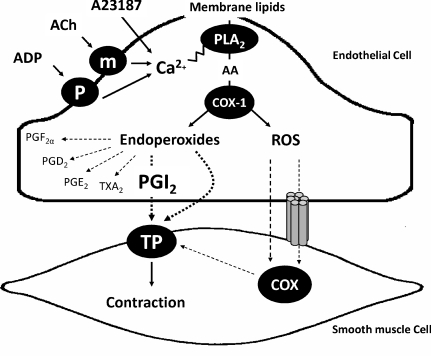Figure 4.
The chain of events leading to the occurrence of endothelium-dependent contractions first involves an abnormal increase in intracellular calcium (which can be evoked by receptor-dependent agonists, such as acetylcholine or ADP, or mimicked with calcium-increasing agents, such as the calcium ionophore A23187) that presumably activates phospholipase A2 to release arachidonic acid. The endothelial COX-1 isoform metabolizes the fatty acid into endoperoxides which per se are EDCF or are transformed predominantly into prostacyclin that subsequently causes contraction by activating the TP receptors of the underlying vascular smooth muscle cells. Reactive oxygen species generated in the endothelium may reach the smooth muscle layer by passive diffusion or through myoendothelial gap junctions and serve to amplify TP receptor-mediated contractions by activating the cyclooxygenase of the vascular smooth muscle. AA, arachidonic acid; ACh, acetycholine; ADP, adenosine diphosphate; m, muscarinic receptors; P, purinergic receptors; PGD2, prostaglandin D2; PGE2, prostaglandin E2; PGF2α, prostaglandin F2α; PGI2, prostacyclin; PLA2, phospholipase A2; ROS, reactive oxygen species; TXA2, thromboxane A2.

